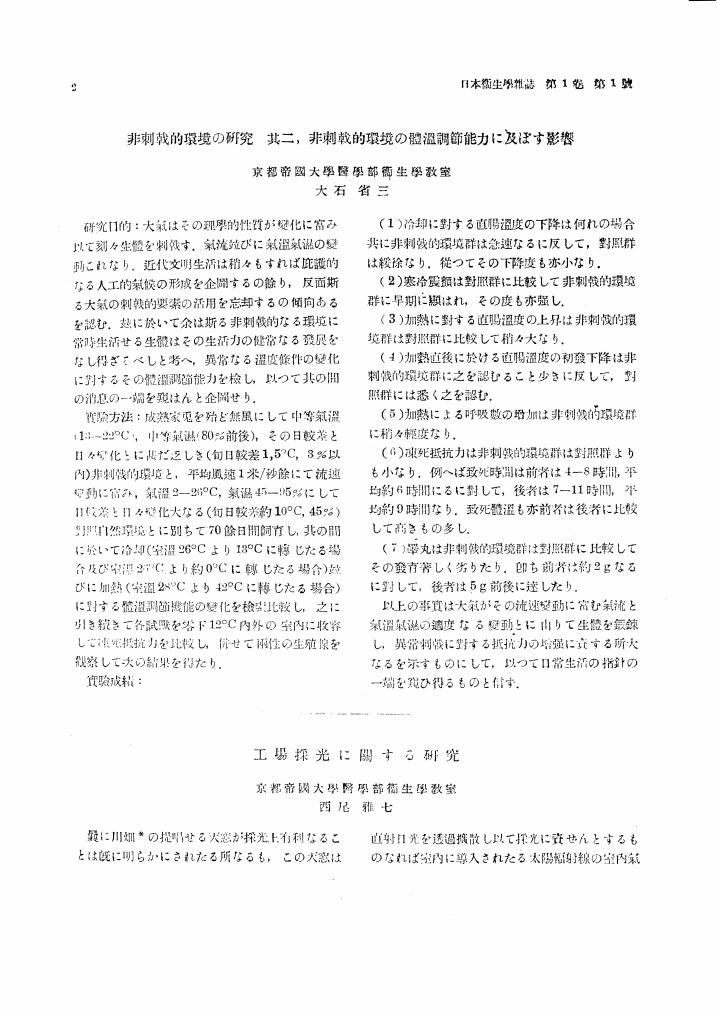4 0 0 0 OA 京都における森永ひ素ミルク中毒被災児の現状
- 著者
- 山下 節義 土居 真 西尾 雅七 北條 博厚 田中 昌人
- 出版者
- 日本衛生学会
- 雑誌
- 日本衛生学雑誌 (ISSN:00215082)
- 巻号頁・発行日
- vol.27, no.4, pp.364-399, 1972-10-28 (Released:2009-02-17)
- 参考文献数
- 104
- 被引用文献数
- 19 36
In the summer of 1955, 12, 131 children in western Japan were poisoned as a result of the consumpting “Morinaga Dry Milk” (according to 1956 survey conducted by the Welfare Ministry). 130 of children actually died as a result of this poisoning. The arsenic contained in the milk resulted from the poorly purified “Secondary Sodium Phosphate” used as a stabilizer in the manufacturing process of powdered milk.The afflicted infants were those for whom the powdered milk served as a main food and who were physically and mentally in the developing process. Such mass-poisoning had heretofore never been reported in the world.As the symptoms of poisoning disappeared, these children were thought to have been cured. The issue was closed medically and administrationally in 1956 as the conclusion had been reached that there would be no longlasting effects.In 1969, Dr. Maruyama et al. (J.J.P.H. Vol. 16, No. 3, p. 170, 1969) reported continuing effects of this arsenic poisoning, once more reviving the medical and social problem. From that time, surveys of these patients were carried out in several places in western Japan.In Kyoto, from December 1970 to July 1971, inclusive checks were done as follows: Epidemiological Survey (415 Subjects), Clinical Survey (291 Subjects) and Clinical Psychological Survey (261 Subjects).The Kyoto victims presented the following:1. In Kyoto, many victims had a much higher rate of physical and mental complaints than the control group.2. Average height was less than that of the same age group.3. Rate of victims who showed proteinuria (male 14%, female 12%) was higher than that of the same age group.4. Abnormal and borderline brain waves were found to be much higher rate in victims (abnormal 14%, borderline 17%) than average.5. The younger the age of milk consumption, the higher were the rates of abnormal brain waves.6. Central nervous system disorders eq. epilepsy, minimal brain damage syndrome, mental retardation etc. were found to be higher rate than average.7. Numbers of the patients with hardness of hearing (18%) were above average.8. Numbers of the patients with anomaly of refraction (48%) were above average.9. Many victims (64%) had symptoms of skin that characterized pigmentation and depigmentation rashes etc..10. Tooth enamel dysplasia was found in higher rates among victims.11. Numbers of victims (21%) with an IQ of less than 85 exceeded average numbers, according to Educational Ministry Statistics.12. In psychological tests, eq. Uchida-Kraepelin methods, atypical group in victims was found to be higher rate than average.13. Many had irregular and painful menstruation.14. Many complaints of victims continued from infancy.15. The result of this follow-up study is not inconsistent with the result of pathological and clinical report in 1955.16. Clinical findings and diagnostic reports of this survey are just the same as those in Osaka and Okayama etc.As mentioned above, it can be concluded that the physical and mental defects of these victims are the result of consumption of arsenic tainted “Morinaga Dry Milk” and that these persons have received no therapy for 16 years.These victims are now in physical and mental adolescent changes. As they have had no follow-up medical care, a prediction of their health in adult hood is impossible.For these reasons, a continuation of the surveys is most necessary, and, counterplans-social care, health consultations, psychological counselling including educational problems etc.-should be carried out by medical and psychological specialists.
1 0 0 0 OA 工場採光に關する研究
- 著者
- 西尾 雅七
- 出版者
- 日本衛生学会
- 雑誌
- 日本衛生学雑誌 (ISSN:00215082)
- 巻号頁・発行日
- vol.1, no.1, pp.2a-3, 1946 (Released:2010-08-10)
- 参考文献数
- 1
